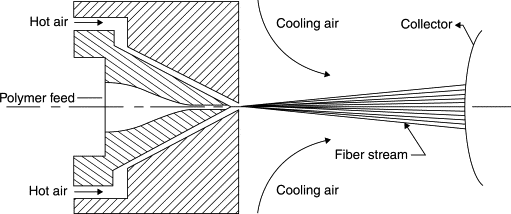

The melt blown process is a one-step process that converts polymer resin into low diameter fiber nonwoven web or tow (Andreas Desch, February 2011). The melt blown process, and its variants, is the only large-scale commercial process that is presently being used to directly produce melt spun fibers with diameters in the submicron range without splitting or chemically dissolving away polymer. It is a nonwovens operation that directly creates fabrics of various widths and thicknesses on large rolls. The products are mainly used in filtration applications, barrier fabrics, oil absorption mats, and battery separators. It is a rapidly growing business segment due to a large increase in the demand for better filtration and membrane medium. The major polymers used in the process are low molecular weight olefins.

The key to the melt blowing process is the spin head. The basic principle is the extrusion of low viscosity polymer melt through a single row of very fine holes placed close together in the order of 1000–4000 holes per m. These holes are usually drilled or made by fusing together two plates that contain etched channels. High velocity hot air is blown at the exit of the holes from both sides of the row of holes at an angle. This air keeps the molten polymer hot and attenuates the molten polymer into a fine fiber. At the same time a flutter is developed in the air stream that causes the fibers to flap rapidly back and forth as they are cooled by ambient air becoming entrained in the process. Finally the fibers are collected on a screen belt or drum.
The fibers produced by this method are generally very weak with low tenacity and modulus. One reason is that low molecular weight (low viscosity) polymer is required to make the process work well. The other factor is that the hot air keeps the polymer in the melt state as it is being attenuated, which is necessary because of the rapid acceleration of the polymer as it exits the spin hole. This results in low axial molecular orientation in the fiber as it is being formed.
There are several issues that influence the melt blown process which are different from other major fiber spinning processes. The first is the design of the extruder screw which is commonly manufactured specifically for the low densities and low viscosities associated with the polymers used in the process. The polymer must also be filtered to a greater level than required in most other fiber spinning processes. Hot compressed air controlled to an exacting temperature must be provided to the process and the angle of insertion and volume (air gap) of the air must be controlled precisely over the length of the spin head. The use of a single row of holes greatly restricts the fiber mass output of the process per meter of web width. This results in production and cost issues. Several attempts with limited results have been made to design heads that solve this issue and still produce low diameter filaments.